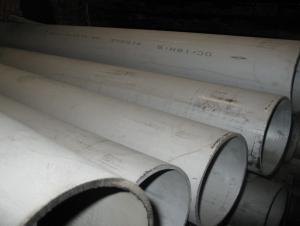hot rolled seamless stainless steel pipe
OKorder Service Pledge
OKorder Financial Service
You Might Also Like
stainless steel pipe
Stainless steel is a production which not easy rust,acid resistance and corrosion resistance,so it is widely used in light industry,heavy industry,daily necessities and the decoration industry.my company long term supply stainless steel porducts including:stainless steel sheet,stainless steel coil and stainless steel tube
Specifications
1.Specification:88.9*5.49 mm or others
2.Surface: NO.1
3.Length:6m or as your requirement
A series of photos
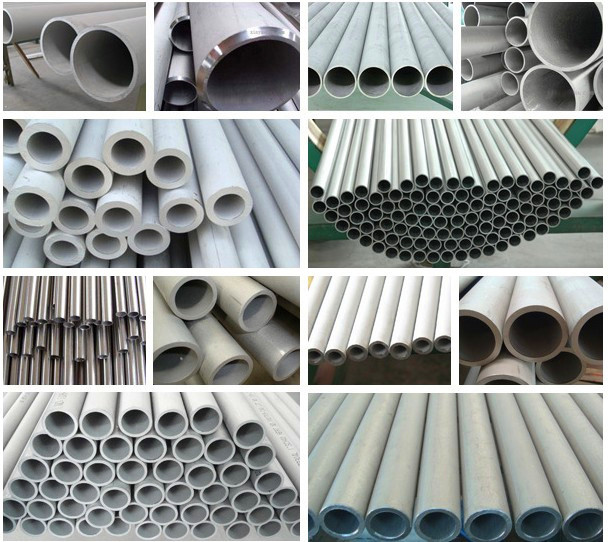
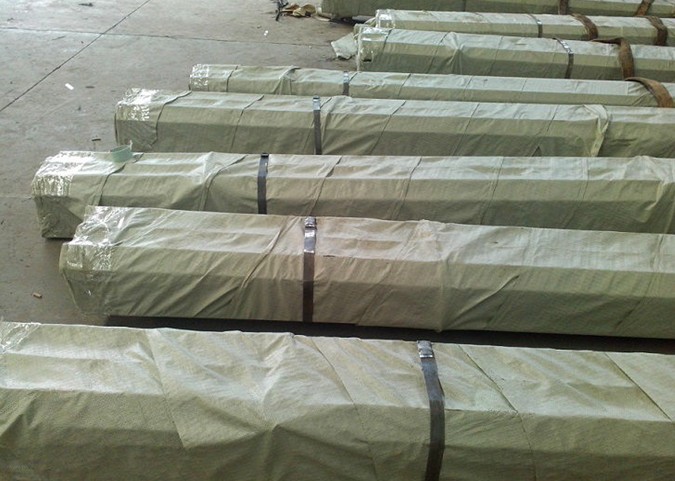

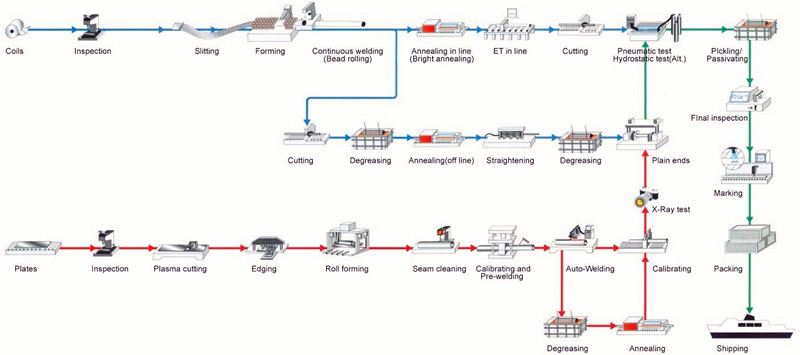
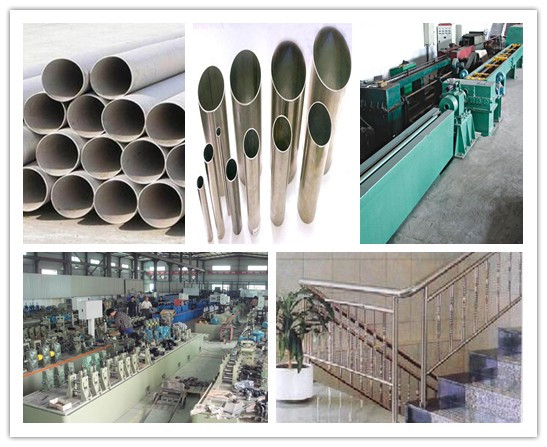
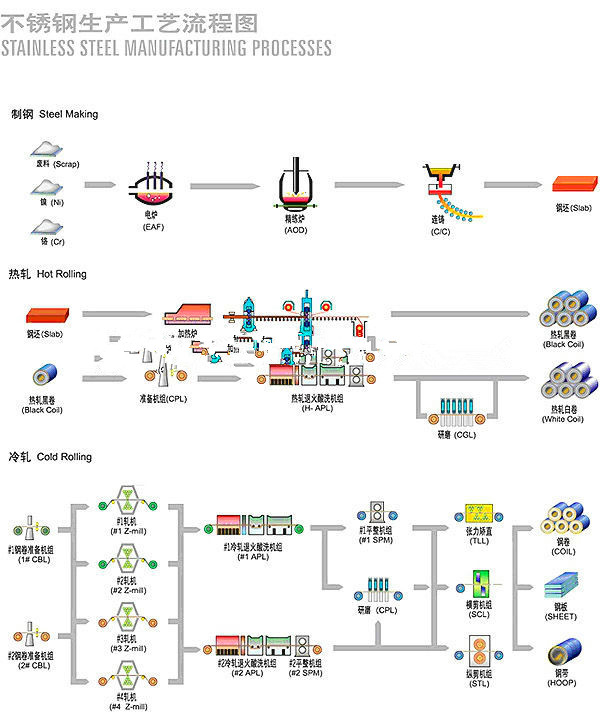
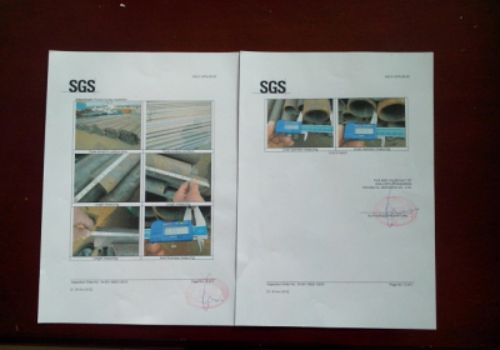
A series of pictures
- Q:Can stainless steel pipes be insulated with polylactide-co-glycolide?
- No, stainless steel pipes cannot be insulated with polylactide-co-glycolide as it is a biodegradable polymer commonly used in medical applications, and it may not provide sufficient insulation for pipes.
- Q:Can stainless steel pipes be used for architectural purposes?
- Stainless steel pipes are indeed capable of being utilized for architectural purposes. The architectural applications of stainless steel are facilitated by several properties it possesses. Firstly, its resistance to corrosion is incredibly high, a crucial factor for structures that are exposed to the elements. Moreover, the sleek and modern appearance of stainless steel pipes can impart an aesthetic touch to architectural designs. In addition to this, stainless steel is a formidable and long-lasting material that provides structural integrity and longevity to buildings. Its versatility allows it to be incorporated into a variety of architectural elements, including handrails, balustrades, staircases, and structural supports. All in all, due to their combination of corrosion resistance, aesthetic appeal, and strength, stainless steel pipes are a widely favored choice for architectural purposes.
- Q:What is the difference between 409 and 316 stainless steel pipes?
- The main difference between 409 and 316 stainless steel pipes lies in their composition and intended use. 409 stainless steel is a ferritic stainless steel, meaning it contains a higher amount of chromium but lower amounts of nickel compared to 316 stainless steel. This makes 409 stainless steel less resistant to corrosion and oxidation, but it is still suitable for applications that involve moderate levels of corrosion resistance, such as automotive exhaust systems and heat exchangers. On the other hand, 316 stainless steel is an austenitic stainless steel that contains higher amounts of both chromium and nickel. Due to its composition, it offers excellent corrosion resistance, even in harsh environments, and is often used in applications where superior resistance to corrosion is required, such as marine environments, chemical processing plants, and medical equipment. In summary, the key differences between 409 and 316 stainless steel pipes are their composition and corrosion resistance. 409 stainless steel is suitable for applications with moderate levels of corrosion resistance, while 316 stainless steel is preferred for applications that require superior corrosion resistance in harsh environments.
- Q:Are stainless steel pipes resistant to erosion-corrosion?
- Stainless steel pipes possess exceptional resistance against erosion-corrosion, making them an optimal option for environments prone to this concern, such as chemical processing plants, oil refineries, and marine settings. This resistance is due to the high chromium content in stainless steel, which forms a protective oxide layer on the metal's surface. Subsequently, this layer acts as a barrier, effectively preventing direct contact between the metal and corrosive substances. Moreover, the smooth surface of stainless steel pipes aids in reducing the impact of erosion, contributing to their prolonged durability and reliability.
- Q:Can stainless steel pipes be cold worked?
- Indeed, cold working is a viable option for stainless steel pipes. By subjecting the metal to deformation at normal temperatures, without any heating prerequisites, the desired outcomes can be achieved. Given the malleable and adaptable nature of stainless steel, shaping and sizing through cold working can be effortlessly accomplished. Techniques like bending, flaring, swaging, and drawing can be effectively employed to meet precise specifications when it comes to stainless steel pipes. Moreover, cold working not only augments the steel's robustness and rigidity but also renders it suitable for diverse applications in sectors such as construction, automotive, and manufacturing.
- Q:Can stainless steel pipes be used for both high and low-pressure applications?
- Yes, stainless steel pipes can be used for both high and low-pressure applications. Stainless steel is known for its strength, durability, and resistance to corrosion, which makes it suitable for various pressure conditions. It can withstand high pressures without deformation or rupture, making it ideal for high-pressure applications such as oil and gas pipelines, chemical processing plants, and hydraulic systems. Additionally, it can also be used in low-pressure applications such as plumbing systems and water supply lines. The versatility of stainless steel pipes allows them to be used in a wide range of pressure conditions, making them a popular choice in many industries.
- Q:How do stainless steel pipes compare to PVC pipes?
- Stainless steel pipes and PVC pipes are both widely used in various industries and applications, but they have distinct differences that make them suitable for different purposes. One of the key differences is the material composition. Stainless steel pipes are made from an alloy of iron, chromium, and other elements, which provides excellent strength and corrosion resistance. On the other hand, PVC pipes are made from a synthetic plastic polymer known as polyvinyl chloride, which offers good chemical resistance but is not as strong as stainless steel. In terms of strength and durability, stainless steel pipes have the upper hand. They can withstand high pressure and are highly resistant to heat, making them ideal for applications that involve transporting hot liquids or gases. PVC pipes, although not as strong, are lightweight and flexible, which makes them easier to handle and install in certain applications. Another important aspect to consider is the cost. PVC pipes are generally more affordable than stainless steel pipes, making them a popular choice for residential plumbing and other low-pressure applications. Stainless steel pipes, being more expensive, are often used in industrial settings where their superior strength and corrosion resistance are necessary. When it comes to lifespan, stainless steel pipes have a longer life expectancy compared to PVC pipes. Stainless steel is highly resistant to corrosion, rust, and other chemical reactions, which allows it to maintain its structural integrity over a longer period of time. PVC pipes, while durable, can degrade over time due to exposure to UV light, extreme temperatures, and certain chemicals. In terms of environmental impact, PVC pipes have raised concerns over the years due to the production and disposal of PVC, which involves the release of toxic chemicals. Stainless steel pipes, on the other hand, are considered more environmentally friendly as they can be recycled and have a longer lifespan. In summary, stainless steel pipes and PVC pipes have their own unique characteristics and advantages. Stainless steel pipes excel in strength, durability, and corrosion resistance, making them suitable for high-pressure and high-temperature applications. PVC pipes, on the other hand, are lightweight, affordable, and easy to install, making them a popular choice for low-pressure applications. Ultimately, the choice between these two materials depends on the specific requirements and constraints of the project at hand.
- Q:What is the difference between satin and brushed finishes in stainless steel pipes?
- Stainless steel pipes can undergo two common types of surface treatments: satin and brushed finishes. These finishes enhance the pipes' appearance and provide some level of corrosion resistance, but they have distinct differences. To achieve a satin finish, a smooth, glossy surface is created using a fine abrasive material. This finish is characterized by its reflective and shiny appearance, similar to satin fabric. It gives the stainless steel pipe a sleek and polished look, making it suitable for applications where aesthetics are important. Satin finishes are commonly used in architectural and decorative applications like handrails, furniture, and kitchen appliances. On the other hand, a brushed finish is achieved by creating a pattern of fine lines on the surface using a wire brush or abrasive pad. This finish has a matte appearance with visible parallel lines running across the surface. Brushed finishes are less reflective than satin finishes and offer a more subdued, industrial look. They are commonly used in applications where durability and resistance to visible wear and tear are important, such as machinery, automotive components, and commercial kitchen equipment. While both satin and brushed finishes provide some level of corrosion resistance, it's worth noting that the surface texture of brushed finishes makes them slightly more resistant to visible scratches and scuffs compared to satin finishes. However, it's important to remember that the overall corrosion resistance of stainless steel is primarily determined by its alloy composition, not the surface finish. In summary, the main difference between satin and brushed finishes in stainless steel pipes lies in their appearance and intended use. Satin finishes offer a reflective and polished look suitable for decorative applications, while brushed finishes provide a more matte and industrial appearance for applications that require durability and resistance to visible wear and tear.
- Q:What are the factors to consider when selecting a stainless steel pipe for a specific application?
- When selecting a stainless steel pipe for a specific application, there are several factors to consider. These factors include the required corrosion resistance, temperature and pressure requirements, the type of fluid or gas being transported, the pipe size and thickness, the desired strength and durability, and any specific industry standards or regulations that need to be followed. Additionally, the cost, availability, and ease of installation should also be taken into account. Overall, it is important to carefully evaluate these factors to ensure that the chosen stainless steel pipe is suitable for the intended application.
- Q:How do stainless steel pipes compare to PEX pipes?
- Stainless steel pipes and PEX pipes have different characteristics and applications, which make them suitable for different plumbing systems. Stainless steel pipes are known for their durability and strength. They are highly resistant to corrosion, which makes them ideal for use in water supply systems, especially in areas with aggressive water conditions. Stainless steel pipes can withstand high pressure and temperature, making them suitable for both residential and commercial applications. They are also fire-resistant, which adds to their safety profile. Additionally, stainless steel pipes have a long lifespan and require minimal maintenance, making them a cost-effective option in the long run. On the other hand, PEX pipes are made of cross-linked polyethylene, which offers flexibility and ease of installation. PEX pipes are highly resistant to freezing and bursting, making them suitable for cold-climate regions. They have the ability to expand and contract, which reduces the risk of leaks or bursts due to temperature changes. PEX pipes are also corrosion-resistant, eliminating the need for expensive and time-consuming maintenance. Additionally, PEX pipes are quieter compared to metal pipes, as they dampen noise and vibration. When choosing between stainless steel pipes and PEX pipes, it is essential to consider factors such as the specific plumbing requirements, budget, and local building codes. While stainless steel pipes excel in durability and strength, PEX pipes offer flexibility and ease of installation. Ultimately, the choice between the two will depend on the specific needs of the plumbing system and the preferences of the homeowner or plumbing professional.
1. Manufacturer Overview |
|
|---|---|
| Location | |
| Year Established | |
| Annual Output Value | |
| Main Markets | |
| Company Certifications | |
2. Manufacturer Certificates |
|
|---|---|
| a) Certification Name | |
| Range | |
| Reference | |
| Validity Period | |
3. Manufacturer Capability |
|
|---|---|
| a)Trade Capacity | |
| Nearest Port | |
| Export Percentage | |
| No.of Employees in Trade Department | |
| Language Spoken: | |
| b)Factory Information | |
| Factory Size: | |
| No. of Production Lines | |
| Contract Manufacturing | |
| Product Price Range | |
Send your message to us
hot rolled seamless stainless steel pipe
OKorder Service Pledge
OKorder Financial Service
Similar products
New products
Hot products
Related keywords
